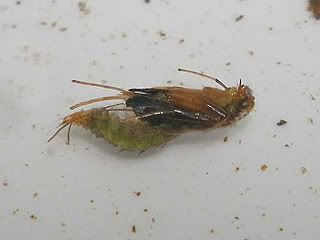or Egg-laying Caddis
This is a killer "happy hour" pattern all summer long when adult caddisflies are bouncing around during egg-laying. By over-powering your forward cast the fly will land with a nice little "splat" and draw vicious strikes in shallow bank runs and pools.
It's not my pattern - in fact I'm not exactly sure who the original creator is, but I first saw it on Mark Libertone's Flymphs, Soft-Hackles, and Spiders website several years ago, and have been tying/using with great success ever since.
-- Hook: #14 wet fly 1X long, 2X heavy (TMC 3761)
-- Thread: olive, UTC 70
-- Egg sac: med/dark olive (DMC embroidery floss nº 935)
-- Body: Hare’s Ear in a twisted dubbing loop (Leisenring style)
-- Ribbing: Flashabou (pearl)
-- Hackle: 2-3 turns gray partridge, stripped on top side (tying "sparse" is key)

P.S. Don't go any lighter than 4X tippet, or you will be breaking fish off... especially after dark (yes - they will find it and keep hitting it).
This is a killer "happy hour" pattern all summer long when adult caddisflies are bouncing around during egg-laying. By over-powering your forward cast the fly will land with a nice little "splat" and draw vicious strikes in shallow bank runs and pools.
It's not my pattern - in fact I'm not exactly sure who the original creator is, but I first saw it on Mark Libertone's Flymphs, Soft-Hackles, and Spiders website several years ago, and have been tying/using with great success ever since.
-- Hook: #14 wet fly 1X long, 2X heavy (TMC 3761)
-- Thread: olive, UTC 70
-- Egg sac: med/dark olive (DMC embroidery floss nº 935)
-- Body: Hare’s Ear in a twisted dubbing loop (Leisenring style)
-- Ribbing: Flashabou (pearl)
-- Hackle: 2-3 turns gray partridge, stripped on top side (tying "sparse" is key)

P.S. Don't go any lighter than 4X tippet, or you will be breaking fish off... especially after dark (yes - they will find it and keep hitting it).





